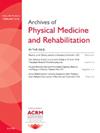Age-associated Rate of Decline of Grip Strength in Adults: NHANES (2011-2014)
IF 3.6
2区 医学
Q1 REHABILITATION
Archives of physical medicine and rehabilitation
Pub Date : 2025-04-01
DOI:10.1016/j.apmr.2025.01.072
引用次数: 0
Abstract
Objectives
To (1) quantify the age-associated rate of decline in grip strength in adults aged ≥30 years (∆kg/y, ∆kg/5-y, ∆kg/10-y), (2) examine sex differences in the rate of decline, and (3) explore differences in the rate of decline among different racial/ethnic groups.
Design
This is a cross-sectional, observational study.
Setting
General community.
Participants
Observed hand grip strength data for both hands were extracted from the National Health and Nutrition Examination Survey (NHANES) 2011-2014 database, comprising 7328 noninstitutionalized participants aged 30-80 years.
Interventions
Not applicable.
Main Outcome Measures
The muscle strength/grip test component measured isometric grip strength using a Takei Digital handgrip dynamometer. Best values (best from 3 trials) of the dominant hand were determined. The “Y2-Y1 rate of change” (in kg/y) was the grip strength difference between consecutive observations. Multiple regression analysis was used to estimate the constant rate of decline.
Results
The decline in handgrip strength varied by sex, with a consistent rate of decline observed as age increased. In male adults, the annual decline rate of the handgrip strength was estimated at 0.353 kg/year, 1.742 kg/5 years, and 3.620 kg/10 years. Conversely, in female adults, the annual decline rate of the handgrip strength was 0.221 kg/year, 1.095 kg/5 years, and 2.243 kg/10 years. Among males, handgrip strength declined 0.353 kg/year for Mexican Americans, 0.358 kg/year for Other Hispanic, 0.377 kg/year for non-Hispanic Whites, and 0.390 kg/year for non-Hispanic Blacks. Similarly, among females, handgrip strength declined at the rate of 0.205 kg/year for Mexican Americans, 0.216 kg/year for Other Hispanic, 0.248 kg/year for non-Hispanic Whites, and 0.244 kg/year for non-Hispanic Blacks.
Conclusions
Grip strength declines at a systematic and predictable rate as the population ages. Here, we estimated the age-associated rate of decline in grip strength.
Disclosures
none.
求助全文
约1分钟内获得全文
求助全文
来源期刊
CiteScore
6.20
自引率
4.70%
发文量
495
审稿时长
38 days
期刊介绍:
The Archives of Physical Medicine and Rehabilitation publishes original, peer-reviewed research and clinical reports on important trends and developments in physical medicine and rehabilitation and related fields. This international journal brings researchers and clinicians authoritative information on the therapeutic utilization of physical, behavioral and pharmaceutical agents in providing comprehensive care for individuals with chronic illness and disabilities.
Archives began publication in 1920, publishes monthly, and is the official journal of the American Congress of Rehabilitation Medicine. Its papers are cited more often than any other rehabilitation journal.

 求助内容:
求助内容: 应助结果提醒方式:
应助结果提醒方式:


